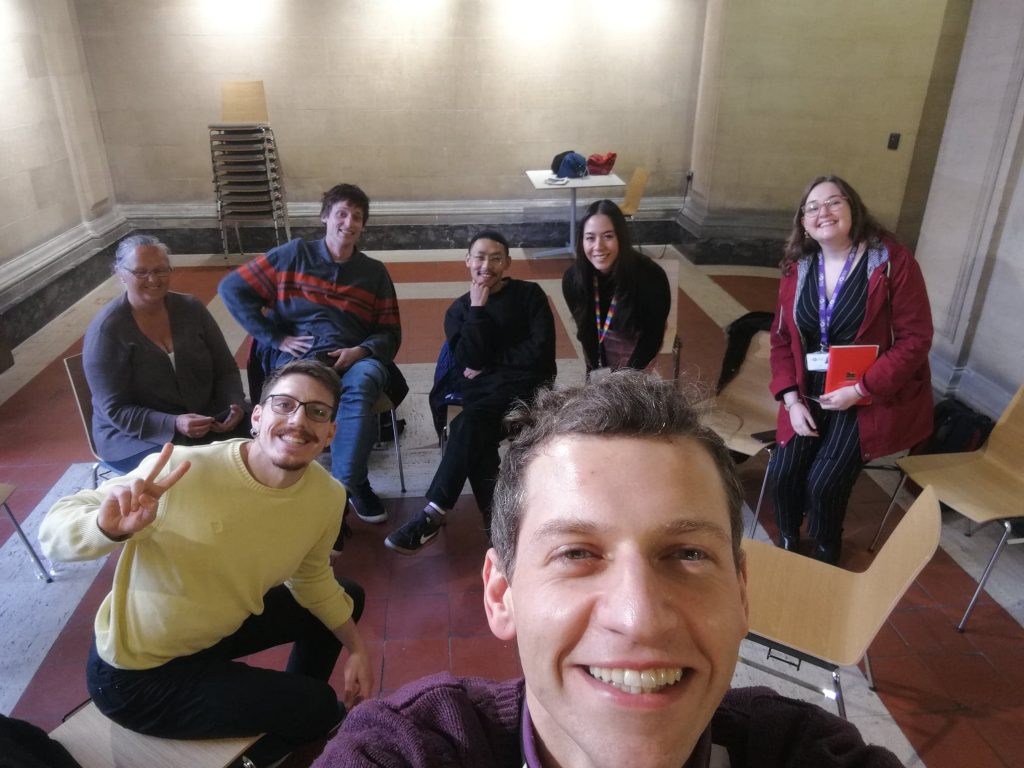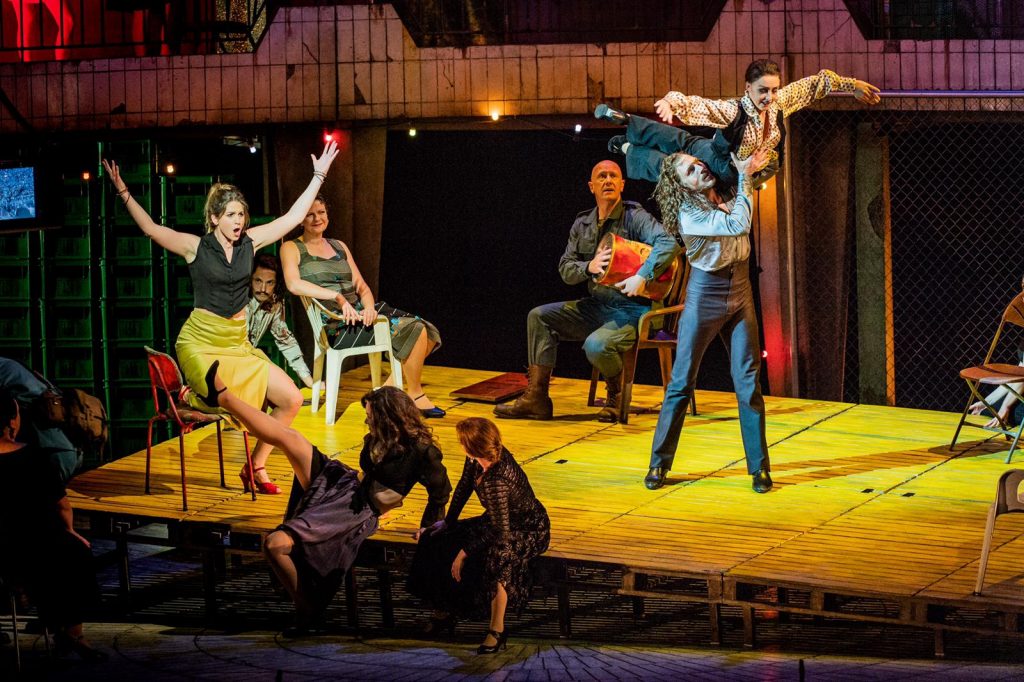Report: Choreographic Talk – WNO’s Carmen
On 13th March 2020, I chaired a public talk with choreographer Carmine De Amicis and dramaturg Elin Jones to learn about the place of dance within the Welsh National Opera’s Carmen. Conveniently located at a few minutes’ walking distance from the Hippodrome where the production was staged on the 11th and 13th of March, the event was held at Park St. Vestibule, one of the two side entrance halls to the Bristol City Council building. The location was offered free of charge thanks to an artist residency agreement with Artspace Lifespace, a registered charity providing vacant and problem properties for use as creative resources in Bristol.

To welcome the participants, I familiarised them with the activities and goals of the Society for Dance Research and I explained that after being recently appointed to join the Executive Committee, I conceived the talk as an initiative to engage people in the West of England and Wales in discussions on dance research. The event developed through a conversation with Carmine while he was touring with the WNO to Bristol. Before joining the WNO, Carmine (whom I have known since growing up in the same hometown in Abruzzo, Italy) had worked internationally as a dancer, choreographer, rehearsal director and associate lecturer at Chichester University. He also worked with Richard Alston Dance Company and Shobana Jeyasingh Dance and is artistic director of EDIFICE Dance Theatre. He entered the WNO last September to work as assistant choreographer for Carmen and Le Nozze di Figaro during the Autumn 2019 season. His role changed however over the last months when he took over as revival choreographer for the restaging of the show (originally conceived by director Jo Davies and choreographer Denni Sayers) with new cast members such as Julia Mintzer in the role of Carmen.
Carmine provided in depth information on how Davies wanted the movements on stage to depict a contemporary gangster environment in a South American favela rather than the 19th century Andalusian Seville as in the original opera by Georges Bizet. To meet the request, he made use of his expertise in hybrid partnering dance form in between Ballroom/Latin American and Contact which he had explored in his Master’s thesis at the University of Chichester. For Carmen, he thus created a choreography that borrowed from different styles such as Tango and Samba, although without explicitly associating them with any specific national culture. A South-American vibe informs for instance the duo at the beginning of Act Two when Carmine dances with the only other dancer in the production, the Contemporary and Flamenco dancer Josie Sinnadurai. A South-America flavour also inspired the overall direction of the movement of the singers on stage. Carmine finally illustrated how he found kinetic strategies to help the singers feel as if they were born in a South-American gang through the exploration of different ways of moving on stage, for instance while walking, standing or smoking.
I then introduced the WNO dramaturg Elin Jones. Originally from Anglesey and an advocate for the arts in Wales, before becoming WNO dramaturg Elin studied at Cardiff University, Humboldt Universität zu Berlin and the Royal Welsh College of Music & Drama, and performed with leading Welsh language opera company Opra Cymru. Elin offered an insight into the original plot of Georges Bizet’s opera and on the WNO adaptation by director Jo Davies. She emphasised that Davies wanted to portray with Carmen a woman leader within a marginal community, a figure whose actions are motivated more by her lower-class status than by her gypsy background. In this production, Carmen became a worker in a tobacco factory by day and the fierce head of a band of firearms smugglers by night. While struggling to become an equal player in a male-dominated society, Carmen tries to step out of the femme fatale cliché to which she had historically been confined. By relocating the setting to what looks like a Brazilian favela and penitentiary centre, the female director revisited the story in light of the #MeToo debate on gender inequality within and beyond the performing arts industry. Intersecting a feminist stance in the heroine’s unwillingness to give up her freedom with attention to her economic and social hardship, Carmen’s murder points both to worldwide domestic violence rates and to the shortage of female directors in opera.

Elin also briefly mentioned that, rather than in the French tradition of the Grand Opéra (such as in Giuseppe Verdi’s Les Vepres Siciliennes, also staged by the WNO at the Hippodrome on the 14th of March), Carmen was originally created as an opéra-comique. In the Grand Opéra tradition, a ballet would often be inserted as a short interval in the middle of the evening, often at the beginning of the second act. This ballet, which could be unrelated to the overall plot, served the mundane demands of the wealthy patrons of the Opera. Some of these patrons would often be uninterested in watching the full performance but would still want to enter the auditorium during the ballet interval to admire the dancers or any members in the audience and arrange plans for consorting after the show. As for convention in the opéra-comique tradition, a dance intermezzo was however not part of the original structure of Carmen. It is in fact only by chance that the duo performed by De Amicis and Sinnadurai happens at the beginning of the second act.
The talk ended after the attendees had their chance to give comments or ask questions to Carmine and Elin. Carmine was asked to say something more about his choreographic strategies in working with artists whose primary profession is singing and acting and who would potentially be less confident in dancing on stage. He thus remarked that he mostly tried ‘not to approach them as a choreographer’ and expect them to start dancing right away. Instead he offered them other kinds of physical stimuli, such as body percussing or singing, so to allow their exploration of movement to develop.
The event lasted one hour and was free to attend. Registration was required through an Eventbrite page. Promotion was done through a Facebook event (also shared on the SDR Facebook page) and well as through leaflets (see following page). The event attracted artists and scholars working in the performing arts, as well as members of the wider public. Participants were: Nadia Zulem, a Mexican dancer who is currently enrolled in a Master’s at the Theatre Department at the University of Bristol; Ivan Chulo, an actor and dancer from Croatia; Diwas Dewan, performance artist from Nepal; Betula O’Neill, a passionate attendee of the Opera who had watched Carmen at the Hippodrome on the 11th of March. A photo of myself with Carmine, Elin and the participants is inserted below.
Sinibaldo De Rosa